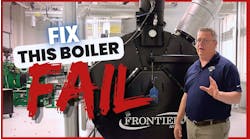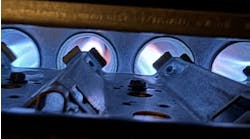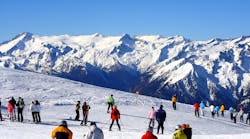Latest from Hydronics
Sponsored
We don’t get much snow where I live, except for a ski slope nearby in mountainous Southeastern Indiana, because they make it themselves. They’ve been doing it with their own snow making technology for a long time and can keep a pretty good size north-facing hillside covered in fake snow for most of the winter.
The problem has always been what to do with the snow that the skiers deposit in and near the lodge on their journey from the slopes to warm up in the lodge. Also, depending on the wind, snow builds up near the entrances to the lodge while they’re making snow. To originally solve the problem, they installed steel grating around the snowy side of the lodge. In theory, the snow falls off the boots/pants/etc. as the skier walks over the grating. Then the snow falls through the open spaces of the grating, keeping the walkway somewhat snow free.
This system worked semi-adequately for years, until the rust bug got into the support structure underneath. This spring they tore the whole 7600 square feet of steel sidewalk off and called me. I had helped them in the past with radiant floors in the snow-cat maintenance shop, the first-aid clinic, and most recently the snow-tube warming hut. Now they wanted to put tubing in the new concrete sidewalk being installed this summer.
The Snow Melt Quote
I met them at the job site to verify what they wanted to do and where they wanted to install equipment, because when you heat that much concrete in the great outdoors to the temperature to melt snow, a lot of equipment is required. I needed to put together a quote for the tubing, manifolds, boilers, pumps, air control, etc., so they could get idea of the scope.
Every snow melt quote starts with a design that is based on the maximum conditions the customer wants to be able to melt snow or ice. The two most important are outdoor temperature and wind speed. If you are designing for a critical application like the ramp to an emergency room, you use the worst-case conditions for your area.
If you are doing a residential driveway, you might use the almost worst-case conditions. My default numbers are zero degrees outside temperature and 10 mile per hour wind, which works out to 147 BTUS per square feet on the chart I grew up with. Today it’s all on a computer program, which the Kid gently reminds me of.
BTUS to Boiler Size
Once you know the BTUS, you have the boiler size. With this being a non-typical application, I consulted with my tubing manufacturer. I told him about the balcony above the whole area that protects it from naturally falling snow. He recommended using the factor of 125 BTUS per square feet. For this job, that works out to 953,250 BTUS, which is real close to the output of a million btu input high efficiency hot water boiler.
Nowadays, I split that into two 500,000 BTU boilers for ease of installation and redundancy. The boiler room piping is like most other jobs, making those selections routine. The system circulator is the critical item to size for snow melt. It needs to overcome the friction loss of a cold glycol/water mix as it circulates through the distribution piping to the manifolds, and then through all that tubing.
Sq. Ft. to Tubing to Pump Size
How much tubing do you ask? The lineal feet of tubing is based on the square footage of the area to be conditioned. Most snow melt applications use tubing spaced on 10” on center distance. The factor for that is 1.2 lineal feet per square feet, so 1.2 times 7626 equals 9150 or so. Now the questions are what size tube and what loop length.
Both determine the friction loss which effects the system pump sizing. Again, I go to my trusted charts from 30-plus years ago, while the Kid goes to his trusted computer program. In the long run, they both produce estimates that we use for design, while the real world determines exact values during operation.
To stay safe, use large diameter tubing and add some safety factor to the pump selection. In this case, I selected ¾” tubing and 287 feet average loop length. The ¾” tubing we sell comes in either 300 or 500 foot rolls. Using the 500 foot rolls, the friction loss was making the pump too expensive. Using the 300 foot rolls, the friction loss was manageable for a stock pump. But with the extra loops, the manifold pricing was going up.
That what’s design is all about, comparing one cost to another. The manifolds are a fixed cost, while the pump has an operating cost. Bigger pumps to overcome higher friction losses on longer loop lengths cost more money to operate, and this application was going to run all winter. I went with the 300 foot rolls.
Flow Rate to Head Loss
To calculate head loss in ¾” tubing, you need to know the flow rate. To get the flow rate, you need to know BTUS per loop. To get that you need to know how many loops. Take the 9150 total lineal feet and divide by the average loop length of 287 to get 32 loops. Divide the 953,250 BTUS by 32 loops to get 29,789 BTUS per loop. To calculate flow rate, pick a water temperature drop, typically with snow melt we use a 25-degree drop.
Time to break out my ever-present System Syzer, line up 25 over 29,789 BTUS and read 2.4 gallons per minute. Now go to friction loss table for ¾” tubing with 30% glycol. The loss is about .05 feet of head per foot of tubing. At 287 ft average loop length, the head loss per loop is just short of 15 ft. Add in the loss for the distribution piping and manifolds—but not the boilers because they are de-coupled by the primary secondary connection—and we have a nice pump ratio of 77 gallons per minute (2.4 GPM per loop x 32 loops) at 22 ft of head.
I applied a safety factor of 25% to the head loss while selecting the pump. A stock three speed in-line circulator does 77 GPM at 29 ft of head on medium speed and 77 GPM at 35 ft of head at high speed. Looks like we got the design covered. I’ll double check with the Kid to see what his computer says.
Patrick Linhardt is a thirty-nine-year veteran of the wholesale side of the hydronic industry who has been designing and troubleshooting steam and hot water heating systems, pumps and controls on an almost daily basis. An educator and author, he is currently Hydronic Manager at the Corken Steel Products Co.
Patrick Linhardt
Patrick Linhardt is a forty-one-year veteran of the wholesale side of the hydronic industry who has been designing and troubleshooting steam and hot water heating systems, pumps and controls on an almost daily basis. An educator and author, he is currently Hydronic Manager at the Corken Steel Products Co.


